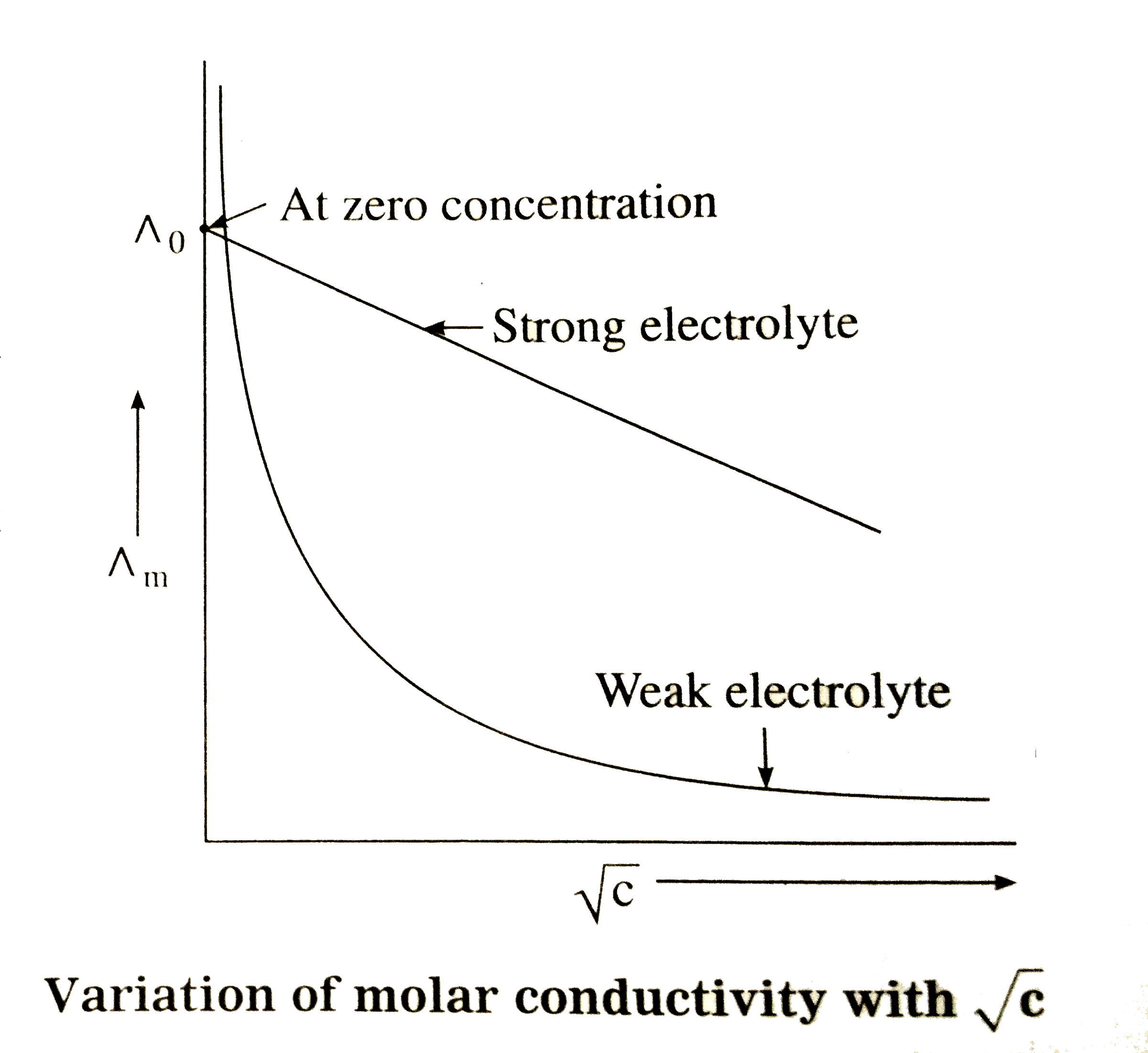How is the molar conductivity of strong electrolytes at zero concentration determined by graphical method? Why is this method not useful for weak electrolytes?
Text Solution
(1) Molar conductivity is the conductance of all the ions produced from one mole of an electrolyte. The molar conductivity of both, strong and weak electrolytes increases with dilution or the decrease in concentration of the electrolytic solution.
As the dilution increase , the dissociation of the electrolyte increases, hence the total number of ions increases, therefore, the molar conductivity increases.
(3) Molar conductivity ∧m is given by ∧m=kC=k×V where k is conductivity and C or V are concentration or dilution of the solution respectively.
(4) On dilution, the molar conductivity of strong electrolytes increase rapidly and approaches to a maximum limiting value at infinite dilution or zero concentration and respresented as ∧∞ or ∧0 or ∧0m .
(5) In case of weak electrolytes, the molar condutivity is low and condutivity is low and increase slowly in high concentration region but incerease rapidly at low concentration or high dilution since the extent of dissocitate inrease with dilution rapily.
For strong electrolytes, the linear variation of molar conductivity (Am) with the concentration is represented by Kohlrausch relation, ∧m=∧0−a√c where a is a constant .
∧0 values for strong electrolytes can be obtained by extrapolating the linear graph to zero concentration (or infinite dilution). However A, for the weak electrolytes cannot be obtained by this method, since the graph increases exponentially at very high dilution and does not intersect ∧m axis,

|
Similar Questions
Knowledge Check
Molar conductivity of an electrolyte is the conductance of all the ions produced by one gram mole of the electrolyte in solution and is denoted as Λm.
Λm=k×1000c
Here k is the specific conductance while c is the molar concentration of the electrolyte. The molar conductance of the strong electrolytes at infinite dilution (Λ∞m) can be obtained graphically by extrapolation while the same for weak electrolytes cannot be obtained graphically. It can be calculated theoretically with the help of Kohrausch's. Law.
Λ∞m(AxBy)=xλ∞m(Ay+)+yλ∞m(Bx)
Which of the following solution of KCl will have the maximum value of specific conductance ?A1.0 NB0.1 NC1.0×10−2 ND0.5 N.STATEMENT 1 : The molar conductivity of strong electrolyte decreases with increases in concentration and
STATEMENT 2 AT high concentration migration of ion is slowAStatement 1 is ture , Statement 2 is true Statement 2 is correct explanation for Statement 1BStatement 1 is true Statement 2 is ture Statement 2 is NOT a correct explantion for Statement 1CStatement 1 is true statement 2 is tureDStatement 1 is false Statement 2 is trueAssertion A: The molar conductance of weak electrolyte is low as compared to that of strong electrolytes at moderate concentrations. Reason R: Weak electrolytes at moderate concentrations dissociate to a much greater extent as compared to strong electrolytes.
AA and R are correct R is the correct explanation of ABA and R are correct R is not the correct explanation of ACA is correct, but R is worngDA is wrong, but R is correct
How the weak and strong electrolytes are distinguished?
View SolutionHow is molar conductivity related to concentration of the electrolyte ? How will you account for this variation for weak and strong electrolytes ?
View SolutionSTATEMENT 1 : The molar conductivity of strong electrolyte decreases with increases in concentration and
STATEMENT 2 AT high concentration migration of ion is slow
View SolutionFor a dilute solution of a strong electrolyte, the variation of molar conductivity with concentration is given by
View SolutionFor a dilute solution of a strong electrolyte, the variation of molar conductivity with concentration is given by
View Solution
